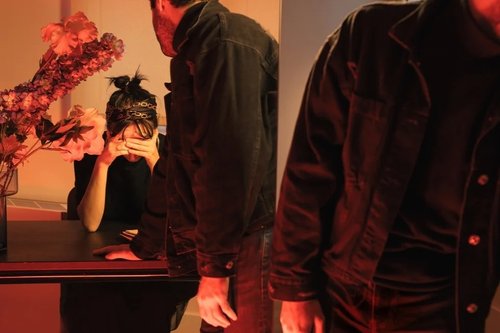Forget the Great Resignation, the real crisis in the workplace is grief
21 sept 2022
11 min


Experts warn that unresolved grief in the aftermath of the pandemic could have a severe impact on people’s physical and mental health and fester into a public health emergency.
Employers are desperate to corral employees, many of them having suffered the loss of loved ones, back to work. But grief remains a taboo subject at work, and productivity-obsessed workplaces are often hostile toward the grieving.
<Trigger warning: mentions suicide.>
Suman* lost her mother to Covid at the peak of the pandemic’s second wave in India last year. Her father, who had several comorbidities, was also fighting the infection. Suman too developed post-Covid complications, including pain in her legs that made standing for long periods difficult.
“My mother was everything to me,” she says. “When she fell ill, we had to turn our house into a mini-ICU since there was no bed available in any hospital. For days, I couldn’t sleep more than three hours.”
Even as she struggled with grief and exhaustion, Suman returned to her workplace — a nonprofit working in human rights and social development.
“It had been barely two weeks since my mother’s passing, but I found zero empathy from the organization,” she says. “Instead, I had to entertain demands of work travel. All attempts at explaining my situation as a grieving person, as someone with post-Covid symptoms, and as a carer to an elderly parent, were ignored.”
The stress triggered the worst anxiety attack of her life. “I thought I was getting a heart attack. It was physically and mentally impossible for me to continue, and even though I was worried about the repercussions, I wanted to resign.”
Suman found strong support in her colleagues, many of whom were her close friends. They were upset at how she had been treated. The organization tried to do damage control, and after talking to her friends, she eventually stayed on. But she had made up her mind that she would leave at the first opportunity.
Earlier this year, she did just that. Her reporting boss, who had fought the management to get her some time off after her mother’s death — only to be told that “No one needs so much time to grieve” — also quit.
Sadly, Suman’s experience is far from unique. Denial of grief and hostility towards the grieving is rampant in our workplaces. And yet we seldom hear about it: the stigma and the fear of adverse career consequences are too great (which explains why several people shared their stories with me anonymously.)
It isn’t difficult to see why grief makes workplaces queasy: Grief is a reminder of loss. Work exists for profit. Grief courses through us in loopy, messy, unwieldy waves; it rises unpredictably and unleashes chaos. Work requires us to participate in a disciplined march towards ever greater productivity; it cannot tolerate chaos.
With the worst of the pandemic seemingly behind us (or at least we are pretending it is), employers are desperate to corral employees back to business as usual. But what we aren’t talking about enough is what this return to work means for employees struggling with grief.
For this piece, I spoke to workers across (white-collar) sectors about their experiences at work during periods of personal grief. Most of them repeated the same themes: how workplaces lack formal policies and safe spaces to talk about grief; how productivity-obsessed employers gaslight and retraumatize grieving employees; and how a few compassionate individuals are left to bear the burden of compensating for non-existing organizational support.
These stories also contain powerful insights into what a work culture sensitive to grief could look like. (Hint: It’s not about grand gestures but doing the little things right.)
A global crisis
In the pre-pandemic world, grief could be brushed aside as an individual’s problem. This pretense is now unviable. Each of the millions of Covid deaths is estimated to have left an average of nine close family members in grief, according to a 2020 study by the University of Southern California. To boot, pandemic grief is aggravated by a constellation of uniquely painful factors — such as the social isolation of the mourner, the unexpectedness of the death, and lack of closure for family members who couldn’t bid a dignified farewell to loved ones.
It doesn’t bear reminding that the pandemic is just one source of grief in the world circa 2022. There is also climate grief; the grief caused by an increasingly fraught social and political climate that is especially harsh on marginalized populations; and the grief triggered by conflict and war. Indeed, scrolling through our newsfeeds, we flit from one grief to the next. Thanks to social media, we are hyper-connected to each other’s pain. We no longer have the time to honor each separate grief, and even less so to observe the five stages of grieving — denial, anger, bargaining, depression, and acceptance — that grief experts say can help us get closure.
This festering grief could metastasize into a public health crisis. In the New York Times, Allison Gilbert, who has written extensively on the topic, lists a litany of grief-induced health problems, including poor sleep, higher blood pressure, depression, and anxiety.
People who lose a spouse die earlier than their married peers, research has shown. Gilbert also points out that children who lose a parent may suffer lasting consequences, including lower grades and failing in school, as well as increased experimentation with drugs and alcohol.
Neuroscientists claim there is such a thing as the ‘grief brain,’ characterized by an overload of loneliness, sadness, confusion, and other complex feelings. Grief makes it difficult for the brain to concentrate, recall memories, and process the perspective of another person.
Our ability to cope with grief is also connected to privilege. For example, there’s a well-established relationship between poverty and depression.
Gilbert also writes that “Although grief is a universal experience, it can contribute to lifelong racial inequality, as Black Americans experience the loss of loved ones far more frequently and earlier in life than white Americans, contributing to differences in mental and physical health outcomes.”
While the health risks of profound grief are well established, questions remain as to whether certain forms of grief are in themselves an illness. According to psychiatry, grief that exceeds a reasonable timeline and is accompanied by ‘symptoms’ such as yearning for the deceased, emotional detachment, and avoidance of reminders of the reality of the death is not normal but a disorder. This is problematic, especially in the context of work.
For one, grief doesn’t care about clocks and calendars. By labeling all prolonged grief a disorder, the mental healthcare system plays into the hands of employers who measure a person’s worth by their ‘resilience’ — their ability to quickly bounce back from crisis.
“It’s going to be two years that I am grieving,” says medical oncologist Mansi Khanderia in a twitter thread about “prolonged grief disorder.” “It’s not even 1% less painful, only worse. It’s love with no place to go. The Indian society, urban or rural, [whether] in the personal or the professional zone, is [already] apathetic to the bereaved. How [much] worse could calling it a disorder make it?”
What happens when unresolved grief collides with work?
According to the World Economic Forum (WEF), up to 4.5% of the American workforce could be grieving the loss of a loved one. For the $20-trillion US economy, this means that up to $942 billion of productivity and business growth has been directly affected by grief. While it’s hard to find such data for lower-income countries, you can make an educated guess about the scale, considering people in these countries have been disproportionately impacted by the pandemic.
For some people living through profound grief, work can bring welcome relief. When Akanksha Kapoor, a former colleague of mine, lost her father, she was granted only a two-week leave. “It was surprisingly helpful to get back [to work] though because I was in a different city and a different home, and had distraction through the day,” she says.
However, there’s a fine line between using work as a distraction and burying yourself in work as an avoidance technique. Berlin-based writer Zahra Salha Uddin saw grief turn her father into a workaholic, the stress of which then caused a lot of illnesses such as heart disease and pancreatitis. After some recent losses, she found herself dealing with her own unprocessed grief from her childhood. “The pain made it too hard to use work as a coping mechanism,” she says.
This is where an employer can play a critical role. A workplace attentive to grief will help reinforce healthy boundaries and make sure people get the time and space they need to heal. At the other end, a workplace where grief isn’t legitimized will add to the grievers’ trauma.
In a paper on the relationship between grief and the workplace in the aftermath of the 2006-08 financial crisis, Mary Ann Hazen, professor in the College of Business Administration at the University of Detroit Mercy, writes that the behaviors expected of someone in the role of griever, such as expressions of sadness, anger, and exhaustion, are usually unacceptable in the role of employee. “Such expressions by someone in grief can be misunderstood if managers and other employees are uninformed about what to expect from someone grieving and how they might respond.”
Long before the pandemic, Vivek Sharma paid a high price for this failure by his employer. Sharma is a graduate of the Indian Institute of Management, India’s premier business school. For 12 years, he worked in senior roles in the healthcare industry and lived the high-flying corporate life.
Then, eight years ago, Sharma lost his only child, Amogh, to an undiagnosed illness.
“My whole life was about my job,” he says. “I was proud of what I had achieved in my career, and I liked flaunting it. But that day, when I came back home after performing my son’s last rites, I wanted to burn it all down. None of it mattered anymore.”
Still, Sharma joined work in two weeks. “I was conditioned to think that I couldn’t take too much time to grieve even my child’s death. But when I went back to the office, I got no support from my employer.”
At a meeting with the top bosses of the company, Sharma felt lost. “A senior leader told me, ‘Vivek, why are you so low? You are a young man. You can simply produce another child.’ That comment broke me.”
Sharma’s work friends tried to cheer him up, but their gesture came out all wrong. “All they could tell me was, ‘let’s go for a smoke,’ or ‘let’s go for tea.’ They thought I was stressed. I don’t blame them. Most people who have not experienced what I have can’t tell the difference between stress and intense grief.”
Sharma and his wife Sweta attempted suicide twice, but somehow they survived. (Today they run a number of social entrepreneurship projects, including a matrimonial platform for people living with chronic illness, and a healthcare nonprofit. Sharma also has a podcast dedicated to suicide prevention.)
“Employers don’t like to think about death,” Sharma says. “They simply don’t care about people in grief. They just want you to dust yourself off and get on with it.”
For writer and independent consultant Dhruti Shah, the reckoning came after the death of a close relative.
“Not one person in management asked me how I was,” Shah says. “It was very alienating. And there have been several occasions when I worked in newsrooms that I had to beg [for] time to go to funerals. When death is an important part of your culture and community, that is hard.”
Who in an organization is to blame for such lapses? Typically, middle managers are the ones in closest contact with team members, who expect them to be their voice before the higher-ups. Except managers are themselves highly vulnerable to depression and burnout — sometimes even more so than the people they lead.
And even the most well-meaning managers don’t necessarily have the power to effect meaningful cultural change. Often they fight a lonely battle without any backing from the top.
Take the case of Aditi*, a journalist from Delhi, who found herself bedridden with depression during the second wave of the pandemic. At one point, she grew paranoid about her poor performance at work and was set to resign. She credits her recovery to a compassionate boss.
“Not only did my boss grant me leave without any questions, he also took an interest in my treatment and encouraged me to do whatever I needed to feel better. It was such a huge relief.”
Aditi says her boss extended the same courtesy to at least one other teammate — but believes it was a purely personal initiative. “Even in the worst days of the pandemic, when journalists put their own lives at risk every day, we didn’t get a single email from the management,” she says.
What could a healing workplace look like?
What would it take for our workplaces to forge a different relationship with grief? Can work, in fact, help us heal by offering a community of care when we most need it? What does a healing workplace look like?
For starters, these are workplaces where the wellbeing of employees is prioritized by the top management, backed by clear policies, and not left to ad hoc decisions by a few thoughtful managers. They recognize the unique path that grief charts in every individual. Therefore, these workplaces don’t restrict themselves to ‘one size fits all’ solutions, such as the ‘mental health’ and ‘mindfulness’ apps that have become a staple of employee wellbeing programs. Instead, they throw their might behind deep structural reforms, such as creating safe spaces where employees can be vulnerable and share authentic stories, without a business goal attached to it.
Angi Yoder-Maina leads Kenya-based Green String Network, which uses peacebuilding techniques to help communities affected by shared trauma. One of her current projects is with a large international humanitarian organization in Nigeria. “They usually only prioritized output,” Yoder-Maina says. “But now their top boss is prioritizing his team of over 100 and investing in setting up intentional peer support structures and systems. They believe that by providing social support, especially for teams working in a high-stress environment, they will become a better [organization],” she says.
Yoder-Maina is currently training a group of employees — designated “Circle Keepers” — on peer support, who will in turn handhold other employees. In a recent session, she witnessed the team rally around each other and validate each other’s loss and sadness. “It gave me so much hope,” she says. “I wish other organizations would breathe into this.”
The Indian IT giant Wipro started a peer support programme called Mitr (friend in Hindi) way back in 2002. As part of the program, employees volunteer to offer confidential and anonymous telephone-based counseling to colleagues in emotional distress. Becoming a Mitr volunteer requires rigorous training and is a highly competitive process. Volunteers cherish the responsibility and prestige that comes with it, reflected in the low attrition rates from the program, which have delivered a 40% reduction in costs that would have otherwise gone to external counselors.
That last point dispels a common myth in the workplace — that investing in a compassionate culture is expensive. Sure, if you are a company with the deep pockets of Google, you can pay out 50% of a deceased employee’s salary to their significant other for a decade, plus a monthly subsidy for each school-age child, regardless of the employee’s role or tenure.
But as I repeatedly heard over the course of reporting on this story, what employees living through acute personal crises value the most from their employers is simple humanity.
Norah was 24 and less than three months into her job as a content writer in an Indian IT firm when her father passed away from a sudden heart attack.
“The HR team quickly booked a cab for me to get to the hospital,” she says. “Two senior managers from the company came home that evening to show support. The next few weeks are blurry, but I remember they encouraged me to take as much time as I needed. There was no pressure to get back to work.”
Norah’s eventual return to work was rough. Sometimes she would have a fit of panic and rush out of the office. “When I was not working, I spent a lot of time writing about what I was going through and attempting to process it,” she says. “None of this was singled out or remarked upon. It was a low-key environment, and while I struggled, it could have been much worse elsewhere.”
During the pandemic, Vivek Sharma’s assistant lost her mother. He called all his team members and spoke to them about how they could best support her and ease her workload, and even what kind of language they should use with her so that she doesn’t get triggered.
“Our priority was to make her feel safe and comforted,” he says. “For instance, for a few weeks she wanted to spend more time in the office because it was painful for her to be at home without her mother. We don’t work Saturdays but we started keeping the office open so she could use it if she wanted to.”
“I don’t feel we have done anything extraordinary,” adds Sharma. “I know how horrible it is to not get the most basic support from your employer when you are at your most vulnerable.”
*Some names have been changed to protect the speakers’ privacy.
Photo by Thomas Decamps Welcome to the Jungle
Follow Welcome to the Jungle on Facebook, LinkedIn, and Instagram, and subscribe to our newsletter to get our latest articles every day!

Más inspiración: Tanmoy Goswami
Founding editor : Sanity by Tanmoy & lived-experience advocate

Wellbeing washing: Are workplace mental health apps doing more harm than good?
Workers are struggling with mental health. Are employers approaching it the right way?
19 dic 2024

Left behind: Breaking the silence around survivor guilt in the wake of mass layoffs
When you're the last one standing, should you feel grateful, guilty, or both?
08 jul 2024

Resilience is dead. Long live resilience.
Demand for resilience has surged throughout the pandemic. But we need resilient communities, not people forced to adapt to broken systems.
20 jul 2021

‘We need each other’: Monika Jiang on combating loneliness in hybrid work
Hybrid work offers flexibility but can leave us feeling disconnected. Monika Jiang explores how we can rebuild workplace connections.
19 dic 2024

Struggling at work? Here are 3 steps to rebuilding your self-esteem
Low on confidence? Learn how reflection, recharging, and refocusing can help you rebuild self-esteem and thrive professionally.
27 nov 2024

¿Estás buscando tu próxima oportunidad laboral?
Más de 200.000 candidatos han encontrado trabajo en Welcome to the Jungle
Explorar ofertas